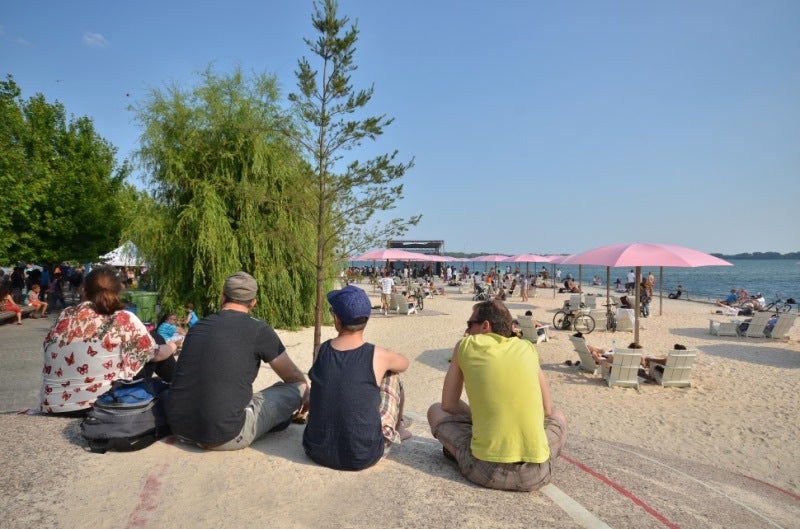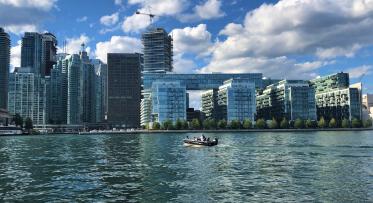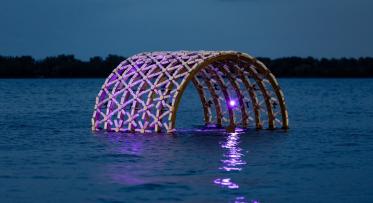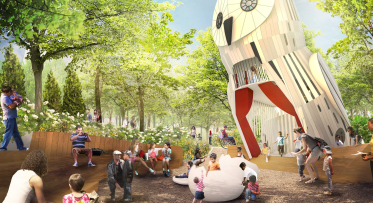It’s More Than Just Umbrellas at Sugar Beach
Canada’s Sugar Beach has been in the news lately, held up as an extravagance and a park created without oversight. All of this is untrue – in fact, Sugar Beach is an excellent example of what Waterfront Toronto was created to do, which is create great parks and public spaces to spur the development of new communities and give the water's edge back to the public. (Image courtesy of Claude Cormier + Associés)
POSTED: JUNE 26, 2014 | DESIGN, PARKS AND PUBLIC SPACES, ECONOMIC DEVELOPMENT, INNOVATION, SUSTAINABILITY
BY: SAMANTHA GILENO
Sugar Beach has been engaging our imaginations since it opened in July 2010. The minute the fences came down, people showed up. They sat on the Muskoka chairs, crawled over the rocks, played in the sand and watched sail boats (and sugar boats!) go by. Then the festivals came. And the concerts. And the fashion shoots. And the TV shows. Not to mention the awards. Lots of them. Just last month, Sugar Beach received a prestigious 2014 Great Places award. Why? Because it is a great place and our waterfront deserves it. 
It is easy to forget that Canada’s Sugar Beach used to be a derelict space. A place to forget and ignore. A parking lot next to a sugar factory. We saw something in that space — a gateway to a new waterfront community. We asked the public to believe in it too. In 2007, we launched a Design Competition for the Jarvis Slip. Sugar Beach by Claude Cormier + Associés was the winning design – selected not only by our jury but by members of the public who were involved every step of the way. Everyone liked that the design built on the City’s system of beaches including Sunnyside, Cherry Beach and HTO Park. And its candy-striped rocks, umbrellas and white sand responded perfectly to its location next to Redpath Sugar – creating a whimsical feeling in an otherwise industrial space.
The candy pink umbrellas at Sugar Beach are one of the park's defining features. And they are built to last – able to withstand hurricane force winds.
Like HTO Park, the design for Sugar Beach also called for umbrellas. As we designed the park, we learned lessons from HTO whose umbrellas were made up of a number of different pieces with mechanical fasteners. These made them less wind resistant and susceptible to sun damage and water damage. The Sugar Beach umbrellas are made of one solid piece of fibreglass and are designed to withstand hurricane force wind in all seasons. This helps extend their overall lifespan which is similar to a fibreglass boat or jet-ski. To make the beach safer at night, we also integrated lighting into each umbrella. That means the umbrella is more than an umbrella – it’s also a light fixture. Each umbrella/light cost just over $11,000 to build and install. To put that in perspective, a standard city lightpole costs $5,000 before it’s even fitted out with additional equipment.
Another key part of the park’s design was its two large candy-striped granite rocks. If you’ve ever put granite in your kitchen – you understand how durable it is. It lasts forever and requires no maintenance. Like all waterfront projects, the granite for Sugar Beach was sourced responsibly from a quarry in northern Quebec. Its cost? About $500,000 to quarry, cut, transport and install using a 165 tonne crane. Is it cheap? No. But, as an integral part of the park’s design the granite was included in the park’s $14 million budget which was approved by our government partners and shared with the public. The budget also included Muskoka chairs, beach, granite pavers, benches, trees, silva cells (which have helped those trees more than double in size) and on and on. The granite rocks at Sugar Beach serve many purposes. They’re for play and for seating. But they’re also for beauty and design. Toronto’s waterfront deserves beautiful space that will last a lifetime.

The candy striped granite outcroppings are great for sitting, climbing and scrambling over – but they're also just for whimsy, beauty and design. And that's okay.
So what it really comes down to is a question of value. Are beautiful spaces like Sugar Beach, Sherbourne Common and Corktown Common valuable? While we can’t quantify the value of a pleasant afternoon by the lake, we do know that building parks and public spaces early in the development process helps attract developers who will pay for the land, help to create new communities (including affordable rental housing) and invest money in our waterfront. To date, Waterfront Toronto’s revitalization model – of which parks and public spaces is a key component – has helped to attract $2.6 billion in new development to the waterfront. And for those who like to see the public sector follow the lead of the private sector, the tax and other revenue generated to date by Waterfront Toronto’s revitalization work have effectively paid back the original $1.5 billion government investment.
So yes, the umbrellas cost $11,000 – but they are part of creating a great park, a great space, a great new community and a great waterfront that has already paid back the investment.




